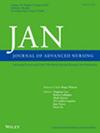长期护理中的护理角色映射:基于网络分析的系统综述。
IF 3.4
3区 医学
Q1 NURSING
引用次数: 0
摘要
目的:综合关于护士在长期护理环境中的作用的证据,并绘制他们之间的相互作用。设计系统评价与网络分析。方法采用主题综合方法确定护士的角色,并通过网络分析绘制其跨领域的相互作用。数据来源检索2014 - 2024年的护理及相关健康文献累积索引、PubMed、Embase、Cochrane图书馆、研究信息共享服务和期刊信息学术数据库。混合方法评估工具评估研究质量。结果共纳入15项研究。护士的角色跨越六个领域:协作、教育、领导、以居民为中心的护理、质量改进和资源管理。网络分析显示协作和领导是最核心的,每一个都有5度中心性,作为跨领域的桥梁。出现了三个专题组:侧重于业务团队合作的协作和资源管理;以加强系统护理为中心的领导力和质量改进;教育和以住院医生为中心的护理强调培训和以住院医生为中心的护理。除了人员短缺和角色模糊等障碍外,还发现了技术能力差距。结论护士角色的相互关联对以病人为中心的护理至关重要;然而,它们需要系统的支持来解决障碍和技术差距。对专业和/或患者护理的影响加强跨专业培训,领导力发展和数字技能整合可以提高长期护理环境中的护理质量和护士福祉。影响本研究探讨了护士在长期护理中角色的复杂性及其结构性互动,发现协作和领导是三个角色集群和技术差距的关键,影响长期护理护士、教育工作者和政策制定者,为劳动力战略提供信息。本研究遵循PRISMA 2020指南,并在PROSPERO进行预注册(CRD42024588422)。患者或公众的贡献本研究的设计、实施或报告中没有患者或公众的参与。试用注册:crd42024588422。本文章由计算机程序翻译,如有差异,请以英文原文为准。
Mapping Nursing Roles in Long-Term Care: A Systematic Review With Network Analysis.
AIM
To synthesise evidence on nurses' roles in long-term care settings and map their interactions.
DESIGN
Systematic review with network analysis.
METHODS
Thematic synthesis was used to identify nurses' roles, and network analysis mapped their interactions across domains.
DATA SOURCES
Six databases-Cumulative Index to Nursing and Allied Health Literature, PubMed, Embase, Cochrane Library, Research Information Sharing Service and Database of Periodical Information Academic-were searched for peer-reviewed articles from 2014 to 2024. The Mixed Methods Appraisal Tool assessed study quality.
RESULTS
Fifteen studies were included. Nurses' roles spanned six domains: collaboration, education, leadership, resident-centred care, quality improvement and resource management. Network analysis revealed collaboration and leadership as the most central, each with a degree centrality of five, acting as bridges across domains. Three thematic clusters emerged: collaboration and resource management focused on operational teamwork; leadership and quality improvement centred on systemic care enhancements; and education and resident-centered care emphasised training and resident-focused care. A technological competence gap was identified, alongside barriers like staffing shortages and role ambiguity.
CONCLUSIONS
Nurses' interconnected roles are critical for resident-centered care; however, they require systemic support to address barriers and technological gaps.
IMPLICATIONS FOR THE PROFESSION AND/OR PATIENT CARE
Enhanced interprofessional training, leadership development and digital skill integration can improve care quality and nurse well-being in long-term care settings.
IMPACT
This study addressed the complexity of nurses' roles in long-term care and their structural interactions, finding collaboration and leadership as pivotal with three role clusters and a technological gap, impacting long-term care nurses, educators and policymakers to inform workforce strategies.
REPORTING METHOD
This study adhered to the PRISMA 2020 guidelines and was preregistered in PROSPERO (CRD42024588422).
PATIENT OR PUBLIC CONTRIBUTION
This study did not include patient or public involvement in its design, conduct or reporting.
TRIAL REGISTRATION
PROSPERO: CRD42024588422.
求助全文
通过发布文献求助,成功后即可免费获取论文全文。
去求助
来源期刊
CiteScore
6.40
自引率
7.90%
发文量
369
审稿时长
3 months
期刊介绍:
The Journal of Advanced Nursing (JAN) contributes to the advancement of evidence-based nursing, midwifery and healthcare by disseminating high quality research and scholarship of contemporary relevance and with potential to advance knowledge for practice, education, management or policy.
All JAN papers are required to have a sound scientific, evidential, theoretical or philosophical base and to be critical, questioning and scholarly in approach. As an international journal, JAN promotes diversity of research and scholarship in terms of culture, paradigm and healthcare context. For JAN’s worldwide readership, authors are expected to make clear the wider international relevance of their work and to demonstrate sensitivity to cultural considerations and differences.

 求助内容:
求助内容: 应助结果提醒方式:
应助结果提醒方式:


